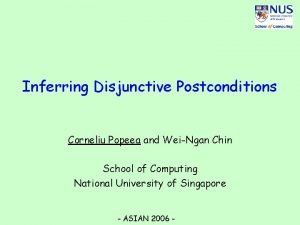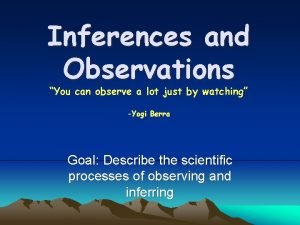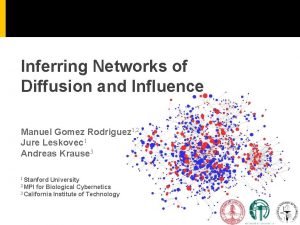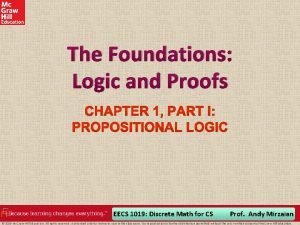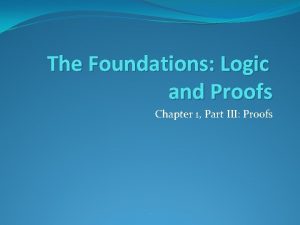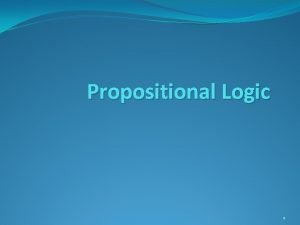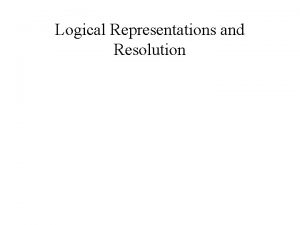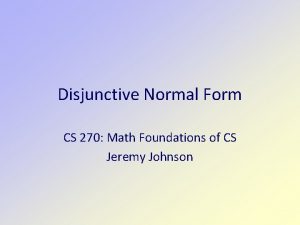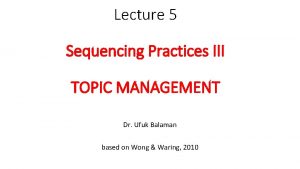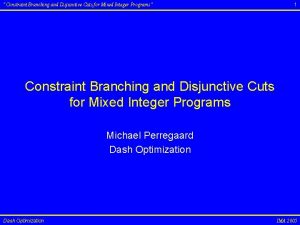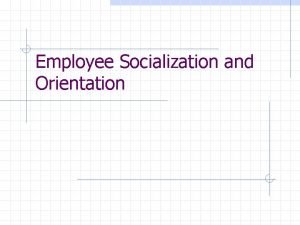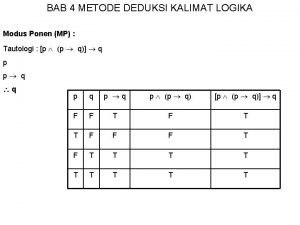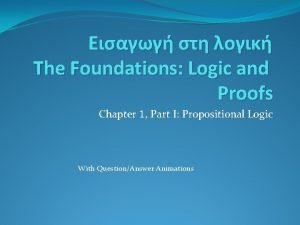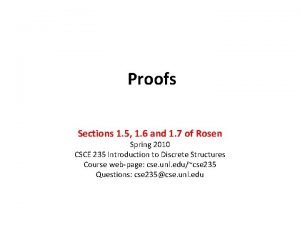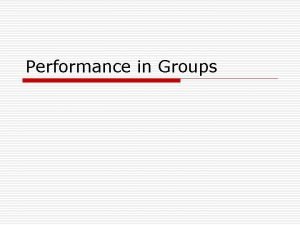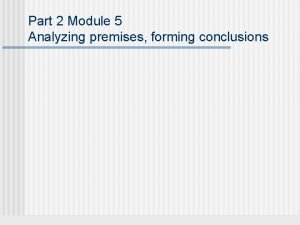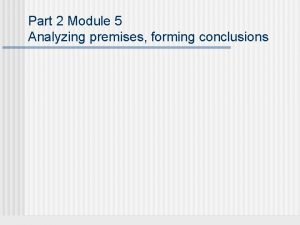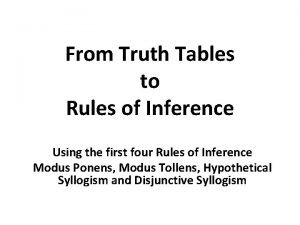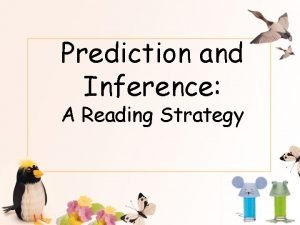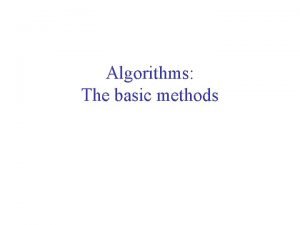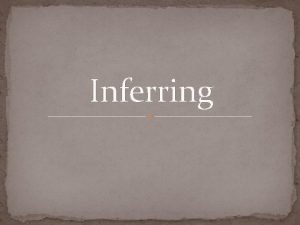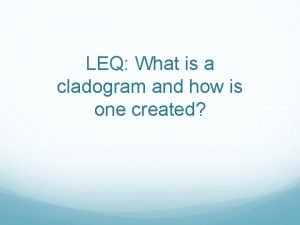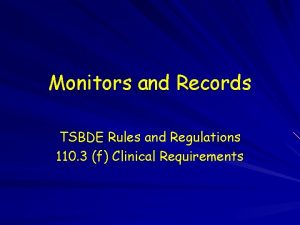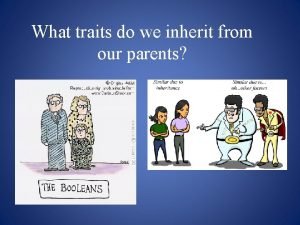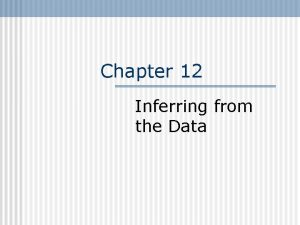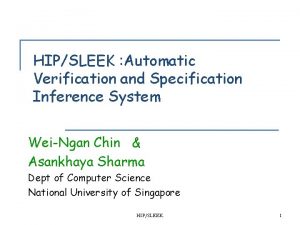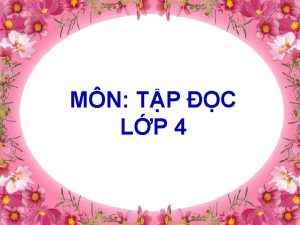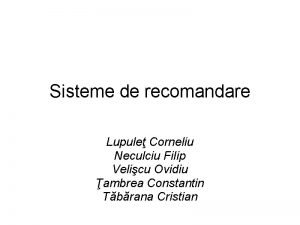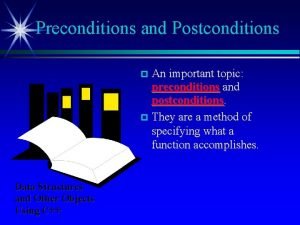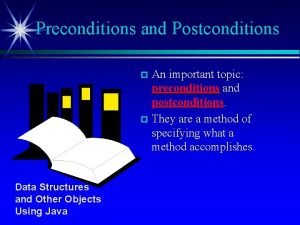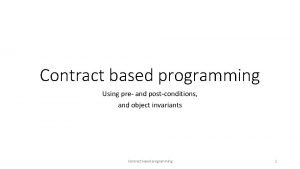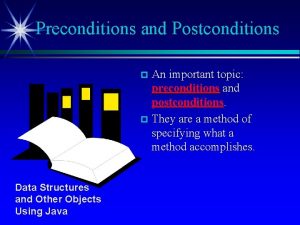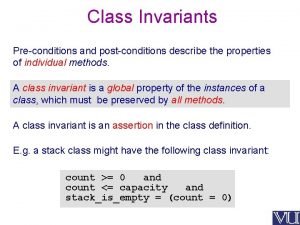Inferring Disjunctive Postconditions Corneliu Popeea and WeiNgan Chin





![Abstract Domain of Polyhedra [Cousot-Halbwachs: POPL'78] Defined as a lattice: <L, v, ? , Abstract Domain of Polyhedra [Cousot-Halbwachs: POPL'78] Defined as a lattice: <L, v, ? ,](https://slidetodoc.com/presentation_image/8e8380ebf86c8cb3d3e9b533508cdfd1/image-6.jpg)







![Affinity Measures (1) • Based on Hausdorff distance [SAS'06]: h-heur(P, Q) = maxx 2 Affinity Measures (1) • Based on Hausdorff distance [SAS'06]: h-heur(P, Q) = maxx 2](https://slidetodoc.com/presentation_image/8e8380ebf86c8cb3d3e9b533508cdfd1/image-14.jpg)






![Implementation • Haskell + Omega library [Pugh et al] • Automate disjunctive postcondition inference. Implementation • Haskell + Omega library [Pugh et al] • Automate disjunctive postcondition inference.](https://slidetodoc.com/presentation_image/8e8380ebf86c8cb3d3e9b533508cdfd1/image-21.jpg)








![References • [Cousot-Halbwachs: POPL'78] Automatic discovery of linear restraints among variables of a program. References • [Cousot-Halbwachs: POPL'78] Automatic discovery of linear restraints among variables of a program.](https://slidetodoc.com/presentation_image/8e8380ebf86c8cb3d3e9b533508cdfd1/image-30.jpg)





- Slides: 35

Inferring Disjunctive Postconditions Corneliu Popeea and Wei-Ngan Chin School of Computing National University of Singapore - ASIAN 2006 -

Motivation: Infer Precise Invariants x: =0; while (x<len(A)) { if (…) { m: =x; } x: =x+1; /* l 1 */ } return A[m]; /* check if a new minimum has been found */ /* what invariant at l 1 proves assertion ? ? */ /* assert (0·m < len(A)) */ Compute an invariant at l 1 over inputs (x, m, s) + outputs (x', m') (x, m, s, x', m') : - (x¸s Æ x'=x Æ m'=m) Ç (x < s Æ x'=s Æ x·m'< x') 2

Related: Numerical Abstract Domains Conjunctive Num-Abs-Domains: • Interval domain: §x · c [Cousot et al: ISOP’ 76] • Polyhedron domain: a 1 x 1 +. . + anxn · c [Cousot et al: POPL’ 78] Disjunctive Num-Abs-Domains: • Powerset extension of an abstract domain [Cousot et al: POPL’ 79] • Powerset widening [Bagnara et al: VMCAI'04] [Gulavani et al: TACAS'06] • Hulling based on Hausdorff distance [Sankaranarayanan et al: SAS'06] 3

Overview • Constraint abstraction: collected from the method body. • Conjunctive fixpoint analysis. • Disjunctive fixpoint analysis. • Experimental results. 4

Constraint Abstraction • A method is translated to a constraint abstraction: void mn. D (ref int x) { if x>0 { x: =x-1; mn. D(x); } else () mn. D(x, x') = (x· 0 Æ x'=x) } Ç (x>0 Æ 9 x 1. (x 1=x-1Æ (mn. D(x, x')))) - substitution from formal to actual args = [x!x 1, x'!x'] • Next step: derive the lfp of this rec-constraint. 5
![Abstract Domain of Polyhedra CousotHalbwachs POPL78 Defined as a lattice L v Abstract Domain of Polyhedra [Cousot-Halbwachs: POPL'78] Defined as a lattice: <L, v, ? ,](https://slidetodoc.com/presentation_image/8e8380ebf86c8cb3d3e9b533508cdfd1/image-6.jpg)
Abstract Domain of Polyhedra [Cousot-Halbwachs: POPL'78] Defined as a lattice: <L, v, ? , >, t, u> • abstract element: conj. of linear inequalities (convex polyhedron) • partial order: F 1 v. F 2 = F 1)F 2 • bottom: ? = False • top: > = True • lub: F 1 t F 2 = hull(F 1 Ç F 2) • glb: F 1 u F 2 = F 1 Æ F 2 CAbst is a monotone function 8 F 1, F 22 L: if F 1 v. F 2 then f: L -> L f(F 1)vf(F 2) 6

Fixpoint Analysis mn. D( ) = (x· 0 Æ x'=x) Ç (x>0 Æ 9 x 1. (x 1=x-1 Æ )) - relation over inputs (x) + outputs (x') • mn. D 0 = False • mn. Di+1 = mn. D(mn. Di) • Ascending chain: False v mn. D 1 v mn. D 2 v. . v mn. Di v. . 7

Conjunctive Fixpoint Analysis mn. D 1 mn. D 2 = mn. D(False) = mn. D(mn. D 1) mn. D 3 = mn. D(mn. D 2) = (x· 0Æx'=x) = (x· 0 Æ x'=x) Ç (x>0 Æ 9 x 1. (x 1=x-1 Æ (mn. D 1))) = hull((x· 0Æx'=x) Ç (x=1Æx'=0)) = (x-1·x'·x Æ x'· 0) = (x-2·x'·x Æ x'· 0) • Lattice of polyhedra has infinite height: use widening operator. mn. DW 2 = widen(mn. D 2, mn. D 3) = (x'·x Æ x'· 0) • A post-fixpoint has been found when: mn. DW 3 = mn. D(mn. DW 2) = (x'·x Æ x'· 0) mn. D(mn. Di) ) mn. Di 8

Conjunctive Analysis • mn. DCONJ = (x'·x Æ x'· 0) More precision? Disjunctive Analysis • mn. DDISJ = (x· 0Æx'=x) Ç (x>0Æx'=0) mn. D 1 = (x· 0Æx'=x) mn. D 2 = (x· 0Æx'=x) Ç (x=1Æx'=0) mn. D 3 = (x· 0Æx'=x) Ç (x=1Æx'=0) Ç (x=2Æx'=0). . . 9

Powerset Abstract Domain of Polyhedra Defined as a semi-lattice: <L, v, ? , >, t> • abstract element: m-bounded disj of convex poly. • partial order: F 1 v. F 2 = F 1)F 2 • bottom: ? = False • top: > = True • lub: F 1 t F 2 = hullm(F 1 Ç F 2) 10

Disjunctive Fixpoint Analysis • Key Problems: • Maintain precision at reasonable cost. • Ensuring termination of analysis (with widening operator). • Main contributions: • Use disjunct affinity to lift both the hulling and widening operators from the conjunctive to the disjunctive domain. • Precise and fairly-efficient disjunctive polyhedra analysis. 11

Hullm: Selective Hulling • Given F= Çni=1 i (where i are conjunctive formulae) • find the most affine disjuncts for hulling (according to some affinity measure) • ensure the number of disjuncts does not exceed m 12

Geometrical Intuition for Affinity • A good affinity-measure: • should be able to quantify how precisely ( 1Ç 2) can be approximated by hull (the convex-hull result) 1 2 3 4 Compare 1Ç 2 with hull Identify perfect match (100% affinity) 13
![Affinity Measures 1 Based on Hausdorff distance SAS06 hheurP Q maxx 2 Affinity Measures (1) • Based on Hausdorff distance [SAS'06]: h-heur(P, Q) = maxx 2](https://slidetodoc.com/presentation_image/8e8380ebf86c8cb3d3e9b533508cdfd1/image-14.jpg)
Affinity Measures (1) • Based on Hausdorff distance [SAS'06]: h-heur(P, Q) = maxx 2 P { miny 2 Q {|x - y|}} 1 2 3 4 • Not able to distinguish among ( 1, 2) and ( 3, 4) (they have similar Haus-distances). • Less appropriate for a relational domain. 14

Affinity Measures (2) • Planar-Affinity: p-heur( 1, 2) = mset = { c 2 ( 1[ 2) | hull ) c} 1 2 3 4 • Detects that ( 3, 4) has higher affinity. • Suited for relational domains. 15

Example: Hullm and Planar-Affinity • mn. D 3 = (x· 0Æx'=x) Ç (x=1Æx'=0) Ç (x=2Æx'=0) (F 1 Ç F 2 Ç F 3) F 1 F 2 F 3 • Affinhull matrix (F 1, F 2, F 3) F 1 F 2 F 3 - 41 100 - • hull 2(F 1ÇF 2ÇF 3) = (F 1 Ç hull(F 2ÇF 3)) = (x· 0 Æ x'=x) Ç (1·x· 2 Æ x'=0) 16

Overview • Collect a constraint abstraction corresponding to the method body. • Background: Conjunctive fixpoint analysis. • Disjunctive fixpoint analysis. • find related disjuncts for hulling • powerset widening operator • Experimental results. 17

Powerset Widening Given F 1= Çdi and F 2 = Çej (di, ej are conjunctive formulae): • find pairs of related disjuncts di and ej • compute widening on the conjunctive domain: fi = (direj) • result is: F 1 rm F 2 = Çfi Related work: • Bagnara et al [VMCAI'04]: propose to use a connector to combine elements in F 2 (e. g. each connected element will approximate some element from F 1) • Gulavani et al [TACAS'06]: specify a recipe for a connector; but rely on the ability to find one minimal element from a set of polyhedra 18

Powerset Widening - rm • Our solution: • find pairs of related disjuncts based on planar-affinity • Planar-affinity is a good indicator for the number of conjuncts preserved in the result of widening. d 1 d 2 e 1 (d 1Çd 2)rm (e 1Çe 2) = (d 1 re 1) Ç (d 2 re 2) e 2 19

Summary: Disjunctive Fixpoint Analysis mn. D 1 mn. D 2 = mn. D(False) = mn. D(mn. D 1) mn. D 3 = mn. D(mn. D 2) = (x· 0Æx'=x) = hull 2((x· 0Æx'=x) Ç (x=1Æx'=0)) = (x· 0Æx'=x) Ç (x=1Æx'=0) = hull 2((x· 0Æx'=x) Ç (x=1Æx'=0) Ç (x=2Æx'=0)) = (x· 0Æx'=x) Ç (1·x· 2Æx'=0) • Lattice has infinite height: use widening operator. mn. DW 2 = mn. D 2 rm mn. D 3 = (x· 0 Æ x'=x) Ç (x>0 Æ x'=0) • A post-fixpoint has been found when: mn. D(mn. Di) ) mn. Di mn. DW 3 = mn. D(mn. DW 2) = (x· 0 Æ x'=x) Ç (x>0 Æ x'=0) 20
![Implementation Haskell Omega library Pugh et al Automate disjunctive postcondition inference Implementation • Haskell + Omega library [Pugh et al] • Automate disjunctive postcondition inference.](https://slidetodoc.com/presentation_image/8e8380ebf86c8cb3d3e9b533508cdfd1/image-21.jpg)
Implementation • Haskell + Omega library [Pugh et al] • Automate disjunctive postcondition inference. • Does it give more precise results? • Benchmarks: numerical programs written in C-like language. 21

Experimental Results • Infer postconditions with different values for m. • Most precise POST: m=2 (binary search, bubble sort, init array) m=3 (queens, quick sort, LU, Linpack) m=4 (SOR) m=5 (merge sort) 22

Experimental Results (II) • Array bound checks elimination. • Programs proved as safe: m=2 (bubble sort, init array) m=4 (merge sort, SOR) • Planar-Affinity proves redundant more checks than the Hausdorff-based affinity. • Disj-Analysis is useful: as m increases, no. of checks not proven decreases gradually. 23

Summary • Disjunctive polyhedra analysis via affinity. • selective hulling • powerset widening • Implementation of a modular static analyzer based on disjunctive polyhedra domain. • potential for trade-off between precision and analysis cost 24

The End 25

Convex-Hull Operator 1 = (x· 0Æx'=x) 2 = (x=1Æx'=0) hull( 1Ç 2) = (x-1·x'·x Æ x'· 0) x' x x'=x x-1=x' hull( 1Ç 2) 26

Widening Operator 1 = (x-1·x'·x Æ x'· 0) 2 = (x-2·x'·x Æ x'· 0) widen( 1, 2) = (x'·x Æ x'· 0) x' x x'·x widen( 1, 2) x-1·x' x-2·x' 27

Quick Sort Example 28

Quick Sort Example (II) • Conjunctive analysis: discovers a lower bound for result: (res ¸ n) • 3 -Disjunctive analysis: result is a valid index: (0 · res < s) 29
![References CousotHalbwachs POPL78 Automatic discovery of linear restraints among variables of a program References • [Cousot-Halbwachs: POPL'78] Automatic discovery of linear restraints among variables of a program.](https://slidetodoc.com/presentation_image/8e8380ebf86c8cb3d3e9b533508cdfd1/image-30.jpg)
References • [Cousot-Halbwachs: POPL'78] Automatic discovery of linear restraints among variables of a program. • [Bagnara et al: VMCAI'04] Widening Operators for Powerset Domains. • [Gulavani-Rajamani: TACAS'06] Counterexample Driven Refinement for Abstract Interpretation. • [Sankaranarayanan et al: SAS'06] Static Analysis in Disjunctive Numerical Domains. 30

Constraint Abstraction • From a method, the analysis generates a constraint-abstraction: meth => • Constraint language: : : = Æ j Ç j 9 x. j mn(x*) j s (constraint) s : : = a 1 x 1 +. . + anxn · a (linear inequality) a 2 Z, x 2 Var, mn 2 Meth-Name 31

Hullm: Selective Hulling • Given F= Çni=1 i (where i are conjunctive formulae) • find the most affine disjuncts for hulling (according to some affinity measure) • ensure the number of disjuncts does not exceed m hullm (F) = if (n · m) then F else hullm(F - { i, j} [ hull( i, j)) such that 8 a, b 21. . n: affinhull( i, j) ¸ affinhull( a, b) 32

Affinity for Hulling • Compute: • hull operation: hull = hull ( 1 Ç 2) • approx. due to hull: approx = hull Æ : ( 1 Ç 2) • affinhull( 1, 2) = if ( approx=False) then 100 else if ( hull=True) then 0 else heur( 1, 2) 33

Example: rm and Planar-Affinity • mn. D 3 = (x· 0 Æ x'=x) Ç (1·x· 2 Æ x'=0) • mn. D 4 = (x· 0 Æ x'=x) Ç (1·x· 3 Æ x'=0) • Affinwiden matrix e 1 e 2 (d 1Çd 2) (e 1Çe 2) d 1 d 2 100 21 41 34 • mn. D 3 rm mn. D 4 = (d 1 r e 1) Ç (d 2 r e 2) = (x· 0 Æ x'=x) Ç (x>0 Æ x'=0) 34

Loops are Analyzed as Methods • Transform loops into tail-recursive functions. • The proposed fixpoint analysis works both for loops and for general recursion. • Nested loops • Mutually-recursive methods 35
 çej
çej Corneliu cotet
Corneliu cotet Corneliu cotet
Corneliu cotet Corneliu cotet
Corneliu cotet Character traits
Character traits Make inferences based on your observations
Make inferences based on your observations Mood passages examples
Mood passages examples Inferring networks of diffusion and influence
Inferring networks of diffusion and influence Logical equivalence
Logical equivalence Disjunctive syllogism
Disjunctive syllogism This or that tag
This or that tag Disjunction proposition
Disjunction proposition Disjunctive normal form
Disjunctive normal form Equivalent disjunctive form example
Equivalent disjunctive form example Logical form
Logical form Nobody lives in this house question tag
Nobody lives in this house question tag Disjunctive topic shift
Disjunctive topic shift Disjunctive cuts
Disjunctive cuts Serial vs disjunctive
Serial vs disjunctive Contoh soal argumen matematika
Contoh soal argumen matematika Define disjunctive normal form
Define disjunctive normal form Modus ponens
Modus ponens Disjunctive tasks meaning
Disjunctive tasks meaning Forming conclusions
Forming conclusions Forming conclusions
Forming conclusions Rules of inference
Rules of inference What is a prediction in reading
What is a prediction in reading Is making inference simply making a guess
Is making inference simply making a guess Rudimentary rules
Rudimentary rules Making inferences
Making inferences Inferring
Inferring Inferring phylogenies using derived characters
Inferring phylogenies using derived characters Tsbde rules and regulations
Tsbde rules and regulations Macintosh blade placement
Macintosh blade placement Mid digital hair
Mid digital hair
